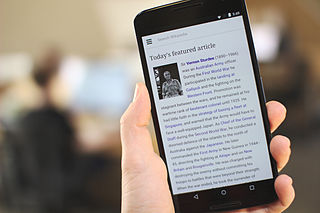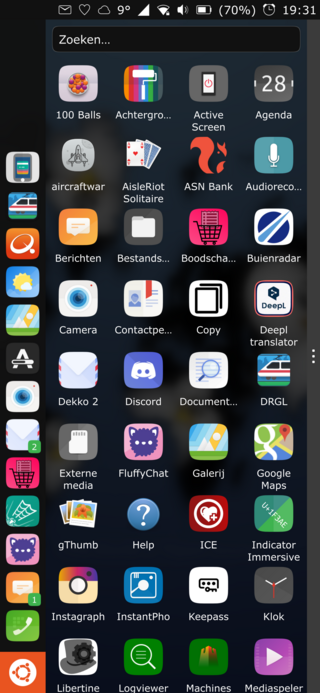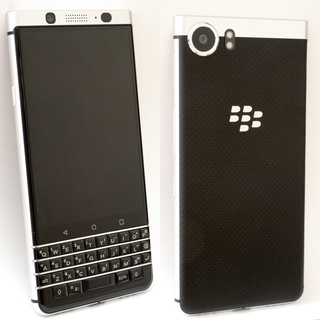
A smartphone, often called simply a phone, is a mobile device that combines the functionality of a traditional mobile phone with advanced computing capabilities. It typically has a touchscreen interface, allowing users to access a wide range of applications and services, such as web browsing, email, and social media, as well as multimedia playback and streaming. Smartphones have built-in cameras, GPS navigation, and support for various communication methods, including voice calls, text messaging, and internet-based messaging apps.
Synaptics, Inc. American neural network technologies and computer-to-human interface devices development company based in San Jose, California. It develops touchpads and fingerprint biometrics technology for computer laptops; touch, display driver, and fingerprint biometrics technology for smartphones; and touch, video and far-field voice, and wireless technology for smart home devices, wearables, and automobiles. Synaptics sells its products to original equipment manufacturers (OEMs) and display manufacturers.

Motorola Mobility LLC, marketing as Motorola, is an American consumer electronics manufacturer primarily producing smartphones and other mobile devices running Android. Headquartered at Merchandise Mart in Chicago, Illinois, it is a wholly owned subsidiary of the Chinese technology company Lenovo.

Cherry, is a Philippine mobile phone and consumer electronics brand by Cosmic Technologies, established by Maynard Ngu in 2009. The company imports mobile phones manufactured in China and markets them under the Cherry Mobile brand. Most of Cherry Mobile's current lineup come with Wi-Fi, capacitive touch screens and run on Android and formerly Windows.

BlackBerry 10 (BB10) is a proprietary mobile operating system for the BlackBerry line of smartphones, both developed by BlackBerry Limited. Released in January 2013, BlackBerry 10 is a complete rework from the company's previous BlackBerry OS software.

Lenovo smartphones are marketed as the "LePhone" in mainland China and the "IdeaPhone" overseas are smartphones designed and manufactured by the Motorola Mobility, ZUK Mobile and Medion, divisions of Lenovo. On April 27, 2017, Lenovo announced that the ZUK brand would cease operations. In 2015, Lenovo subsumed its own smartphone division into the acquired Motorola brand.

Samsung Galaxy Ace 2 (GT-I8160) is a smartphone manufactured by Samsung that runs the Android operating system. Announced and released by Samsung in February 2012, the Galaxy Ace 2 is the successor to the Galaxy Ace Plus.

Ubuntu Touch is a mobile version of the Ubuntu operating system, developed by the UBports community. Its user interface is written in Qt, and is designed primarily for touchscreen mobile devices such as smartphones and tablet computers. However, the original goal of convergence was intended to bring Ubuntu Touch to laptops, desktops, IOT devices and TVs for a complete unified user experience.

Moto X is an Android smartphone developed and manufactured by Motorola Mobility, and released in August 2013.

The Nokia X family was a range of budget smartphones that was produced and marketed by Microsoft Mobile, originally introduced in February 2014 by Nokia. The smartphones run on the Nokia X platform, a Linux-based operating system which was a fork of Android. Nokia X is also known generally as the Nokia Normandy. It is regarded as Nokia's first Android device during the company's Microsoft partnership and was in the process of selling its mobile phone business to Microsoft, which eventually happened two months later.

The HTC One (M8) is an Android or Windows smartphone manufactured and marketed by HTC. Following a number of leaks that occurred during the months prior, the device was officially unveiled in a press conference on March 25, 2014, and released the same day by Verizon Wireless at retail, and by other Canadian and United States carriers for online orders prior to its wider retail availability in mid-April.

The LG G3 is an Android smartphone developed by LG Electronics as part of the LG G series. First released in South Korea on May 28, 2014, it is a successor to 2013's LG G2. Inheriting design elements from the G2, such as its thin screen bezels and rear-mounted power and volume buttons, the G3 is distinguished primarily by being the first smartphone from a major manufacturer to incorporate a 1440p display, and its inclusion of an infrared hybrid autofocus system for its camera. Its video resolution has been upgraded to 2160p (4K). LG also touted the device's plastic "metallic skin"—designed to give the device a higher quality appearance, and a "simpler" user interface with an integrated intelligent personal assistant system. The battery can be quickly changed by the user, allowing charged spare batteries to be carried.

The second-generation Moto G is an Android smartphone developed by Motorola Mobility. Released on September 6, 2014, it is a successor to the original Moto G released in 2013. The phone was initially aimed at developing markets, although it is also available in developed markets as a lower-cost option compared to other phones in its class.

The BlackBerry Priv is a slider smartphone developed by BlackBerry Limited. Following a series of leaks, it was officially announced by BlackBerry CEO John Chen on September 25, 2015, with pre-orders opening on October 23, 2015, for a release on November 6, 2015.
The Huawei Mate 9 is a high-end Android smartphone, designed and produced by Huawei as part of the Huawei Mate series. It was released on 3 November 2016. It was succeeded by the Huawei Mate 10 series, and later the Huawei Mate 20 series.

The BlackBerry KeyOne is a touchscreen-based Android smartphone with an integrated hardware keyboard that is manufactured by TCL Corporation under the brand name of BlackBerry Mobile. Originally known by its unofficial code name "Mercury", the KEYone was officially announced at Mobile World Congress in Barcelona on February 25, 2017. While earlier BlackBerry smartphones running Android exist, the KeyOne is the first Android-based BlackBerry with the iconic BlackBerry design. TCL executives termed the KeyOne as a success, mentioning 850,000 units being sold.

Huawei Mate, formally Huawei Ascend Mate, is a series of high-end HarmonyOS-powered phablet smartphones produced by Huawei, and is one of their flagship products along with the Pura series.
HarmonyOS (HMOS) is a distributed operating system developed by Huawei for smartphones, tablets, smart TVs, smart watches, personal computers and other smart devices. It has a microkernel design with single framework: the operating system selects suitable kernels from the abstraction layer in the case of devices that use diverse resources.

The Xiaomi Mi 5 is a smartphone developed by the Chinese electronics manufacturer company Xiaomi for its high-end smartphone line, released in February 2016. The Xiaomi Mi 5 has a 5.15-inch 1080p screen, a Snapdragon 820 processor, a 3,000-mAh battery and a Sony Exmor IMX 16-megapixel camera. The standard version has 3 GB of RAM with 32 GB of storage space (UFS2.0). The advanced version has the same amount of RAM with 64 GB of storage space (UFS2.0). The premium edition has 4 GB of RAM and 128 GB of storage. It was released 528 days after the Xiaomi Mi 4 went on sale, and the Xiaomi Mi 5 was a long time coming after a flood of flagship phones from different brands.















